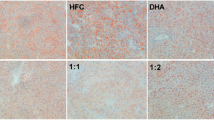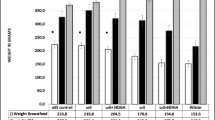Abstract
Ω3-Polyunsaturated fatty acids (Ω3-PUFAs) are known to act as hypolipidaemics, but the literature is unclear about the effects that Ω3-PUFAs have on oxidative stress in obese and diabetic patients. In this study, our aim was to investigate the effects of Ω3-PUFAs on oxidative stress, including antioxidant enzyme activity and hepatic lipid and glycogen metabolism in the livers of diabetic and non-diabetic rats fed on a high fat thermolyzed diet. Rats were divided into six groups: (1) the control group (C), (2) the control diabetic group (D), (3) the high fat thermolyzed diet group (HFTD), which were fed a diet that was enriched in fat that was heated for 60 min at 180°C, (4) the high fat thermolyzed diet diabetic group (D + HFTD), (5) the high fat thermolyzed diet + Ω3 polyunsaturated fatty acid group (HFTD + Ω3), and (6) the high fat thermolyzed diet + Ω3 polyunsaturated fatty acid diabetic group (D + HFTD + Ω3). The most important finding of this study was that Ω3-PUFAs are able to reduce triglycerides, non-esterified fatty acid, lipoperoxidation levels, advanced glycation end products, SOD/CAT enzymatic ratio, and CAT immunocontent and increase SOD2 levels in the livers of diabetic rats fed with a HFTD. However, Ω3-PUFAs did not alter the observed levels of protein damage, blood glucose, or glycogen metabolism in the liver. These findings suggest that Ω3-PUFAs may represent an important auxiliary adjuvant in combating some diseases like diabetes mellitus, insulin resistance, and non-alcoholic fatty liver disease.

Similar content being viewed by others
References
Brownlee M (2001) Biochemistry and molecular cell biology of diabetic complications. Nature 414(6865):813–820. doi:10.1038/414813
Thorpe SR, Baynes JW (1996) Role of the maillard reaction in diabetes mellitus and diseases of aging. Drugs Aging 9(2):69–77
Baynes JW, Thorpe SR (1999) Role of oxidative stress in diabetic complications: a new perspective on an old paradigm. Diabetes 48(1):1–9
Takeuchi M, Yamagishi S (2004) TAGE (toxic AGEs) hypothesis in various chronic diseases. Med Hypotheses 63(3):449–452. doi:10.1016/j.mehy.2004.02.042
Araki N, Ueno N, Chakrabarti B, Morino Y, Horiuchi S (1992) Immunochemical evidence for the presence of advanced glycation end products in human lens proteins and its positive correlation with aging. J Biol Chem 267(15):10211–10214
Brownlee M (1995) Advanced protein glycosylation in diabetes and aging. Annu Rev Med 46:223–234. doi:10.1146/annurev.med.46.1.223
Peppa M, Uribarri J, Vlassara H (2008) Aging and glycoxidant stress. Hormones (Athens) 7(2):123–132
Yoshida T, Yamagishi S, Nakamura K, Matsui T, Imaizumi T, Takeuchi M, Koga H, Ueno T, Sata M (2006) Telmisartan inhibits AGE-induced C-reactive protein production through downregulation of the receptor for AGE via peroxisome proliferator-activated receptor-gamma activation. Diabetologia 49(12):3094–3099. doi:10.1007/s00125-006-0437-7
Fehrenbach H, Weiskirchen R, Kasper M, Gressner AM (2001) Up-regulated expression of the receptor for advanced glycation end products in cultured rat hepatic stellate cells during transdifferentiation to myofibroblasts. Hepatology 34(5):943–952. doi:10.1053/jhep.2001.28788
Smedsrod B, Melkko J, Araki N, Sano H, Horiuchi S (1997) Advanced glycation end products are eliminated by scavenger-receptor-mediated endocytosis in hepatic sinusoidal Kupffer and endothelial cells. Biochem J 322(Pt 2):567–573
Manderson WG, McKiddie MT, Manners DJ, Stark JR (1968) Liver glycogen accumulation in unstable diabetes. Diabetes 17(1):13–16
Figueras M, Olivan M, Busquets S, Lopez-Soriano FJ, Argiles JM (2011) Effects of eicosapentaenoic acid (EPA) treatment on insulin sensitivity in an animal model of diabetes: improvement of the inflammatory status. Obesity (Silver Spring) 19(2):362–369. doi:10.1038/oby.2010.194
Perez-Martinez P, Perez-Jimenez F, Lopez-Miranda J (2010) n-3 PUFA and lipotoxicity. Biochim Biophys Acta 1801(3):362–366. doi:10.1016/j.bbalip.2009.09.010
Bao DQ, Mori TA, Burke V, Puddey IB, Beilin LJ (1998) Effects of dietary fish and weight reduction on ambulatory blood pressure in overweight hypertensives. Hypertension 32(4):710–717
Schmidt B, de Assis AM, Battu CE, Rieger DK, Hansen F, Sordi F, Longoni A, Hoefel AL, Farina M, Goncalves CA, Souza DO, Perry ML (2010) Effects of glyoxal or methylglyoxal on the metabolism of amino acids, lactate, glucose and acetate in the cerebral cortex of young and adult rats. Brain Res 1315:19–24. doi:10.1016/j.brainres.2009.12.008
Lorenzi R, Andrades ME, Bortolin RC, Nagai R, Dal-Pizzol F, Moreira JC (2010) Circulating glycolaldehyde induces oxidative damage in the kidney of rats. Diabetes Res Clin Pract 89(3):262–267. doi:10.1016/j.diabres.2010.05.005
de Assis AM, Rieger DK, Longoni A, Battu C, Raymundi S, da Rocha RF, Andreazza AC, Farina M, Rotta LN, Gottfried C, Goncalves CA, Moreira JC, Perry ML (2009) High fat and highly thermolyzed fat diets promote insulin resistance and increase DNA damage in rats. Exp Biol Med (Maywood) 234(11):1296–1304. doi:10.3181/0904-RM-126
Sandu O, Song K, Cai W, Zheng F, Uribarri J, Vlassara H (2005) Insulin resistance and type 2 diabetes in high-fat-fed mice are linked to high glycotoxin intake. Diabetes 54(8):2314–2319
Horwitz W, Kamps LR, Boyer KW (1980) Quality assurance in the analysis of foods and trace constituents. J Assoc Off Anal Chem 63(6):1344–1354
Levine RL, Williams JA, Stadtman ER, Shacter E (1994) Carbonyl assays for determination of oxidatively modified proteins. Methods Enzymol 233:346–357
Draper HH, Hadley M (1990) Malondialdehyde determination as index of lipid peroxidation. Methods Enzymol 186:421–431
Ellman GL (1959) Tissue sulfhydryl groups. Arch Biochem Biophys 82:70–77
Aebi H (1984) Catalase in vitro. Methods Enzymol 105:121–126
Misra HP, Fridovich I (1972) The role of superoxide anion in the autoxidation of epinephrine and a simple assay for superoxide dismutase. J Biol Chem 247(10):3170–3175
Dolnikoff M, Martin-Hidalgo A, Machado UF, Lima FB, Herrera E (2001) Decreased lipolysis and enhanced glycerol and glucose utilization by adipose tissue prior to development of obesity in monosodium glutamate (MSG) treated-rats. Int J Obes Relat Metab Disord 25(3):426–433. doi:10.1038/sj.ijo.0801517
Krisman CR (1962) A method for the colorimetric estimation of glycogen with iodine. Anal Biochem 4:17–23
Folch J, Lees M, Stanley GHS (1957) A simple method for the isolation and purification of total lipides from animal tissues. J Biol Chem 226(1):497–509
Berson A, De Beco V, Letteron P, Robin MA, Moreau C, El Kahwaji J, Verthier N, Feldmann G, Fromenty B, Pessayre D (1998) Steatohepatitis-inducing drugs cause mitochondrial dysfunction and lipid peroxidation in rat hepatocytes. Gastroenterology 114(4):764–774
Yang SQ, Lin HZ, Lane MD, Clemens M, Diehl AM (1997) Obesity increases sensitivity to endotoxin liver injury: implications for the pathogenesis of steatohepatitis. Proc Natl Acad Sci USA 94(6):2557–2562
Storlien LH, Kraegen EW, Chisholm DJ, Ford GL, Bruce DG, Pascoe WS (1987) Fish oil prevents insulin resistance induced by high-fat feeding in rats. Science 237(4817):885–888
Dyerberg J, Bang HO (1979) Haemostatic function and platelet polyunsaturated fatty acids in Eskimos. Lancet 2(8140):433–435
Dyerberg J, Bang HO, Hjorne N (1975) Fatty acid composition of the plasma lipids in Greenland Eskimos. Am J Clin Nutr 28(9):958–966
Harris WS (1997) n-3 Fatty acids and serum lipoproteins: human studies. Am J Clin Nutr 65(5 Suppl):1645S–1654S
Sato A, Kawano H, Notsu T, Ohta M, Nakakuki M, Mizuguchi K, Itoh M, Suganami T, Ogawa Y (2010) Antiobesity effect of eicosapentaenoic acid in high-fat/high-sucrose diet-induced obesity: importance of hepatic lipogenesis. Diabetes 59(10):2495–2504. doi:10.2337/db09-1554
Dallongeville J, Bauge E, Tailleux A, Peters JM, Gonzalez FJ, Fruchart JC, Staels B (2001) Peroxisome proliferator-activated receptor alpha is not rate-limiting for the lipoprotein-lowering action of fish oil. J Biol Chem 276(7):4634–4639. doi:10.1074/jbc.M008809200
Gaemers IC, Stallen JM, Kunne C, Wallner C, van Werven J, Nederveen A, Lamers WH (2011) Lipotoxicity and steatohepatitis in an overfed mouse model for non-alcoholic fatty liver disease. Biochim Biophys Acta 1812(4):447–458. doi:10.1016/j.bbadis.2011.01.003
Flachs P, Horakova O, Brauner P, Rossmeisl M, Pecina P, Franssen-van Hal N, Ruzickova J, Sponarova J, Drahota Z, Vlcek C, Keijer J, Houstek J, Kopecky J (2005) Polyunsaturated fatty acids of marine origin upregulate mitochondrial biogenesis and induce beta-oxidation in white fat. Diabetologia 48(11):2365–2375. doi:10.1007/s00125-005-1944-7
Jump DB (2004) Fatty acid regulation of gene transcription. Crit Rev Clin Lab Sci 41(1):41–78. doi:10.1080/10408360490278341
Neschen S, Morino K, Dong J, Wang-Fischer Y, Cline GW, Romanelli AJ, Rossbacher JC, Moore IK, Regittnig W, Munoz DS, Kim JH, Shulman GI (2007) n-3 Fatty acids preserve insulin sensitivity in vivo in a peroxisome proliferator-activated receptor-alpha-dependent manner. Diabetes 56(4):1034–1041. doi:10.2337/db06-1206
Yoshida T, Yamagishi S, Nakamura K, Matsui T, Imaizumi T, Takeuchi M, Koga H, Ueno T, Sata M (2008) Pigment epithelium-derived factor (PEDF) ameliorates advanced glycation end product (AGE)-induced hepatic insulin resistance in vitro by suppressing Rac-1 activation. Horm Metab Res 40(9):620–625. doi:10.1055/s-0028-1083785
Magnusson I, Rothman DL, Katz LD, Shulman RG, Shulman GI (1992) Increased rate of gluconeogenesis in type II diabetes mellitus. A 13C nuclear magnetic resonance study. J Clin Invest 90(4):1323–1327. doi:10.1172/JCI115997
Tomiyasu M, Obata T, Nishi Y, Nakamoto H, Nonaka H, Takayama Y, Autio J, Ikehira H, Kanno I (2010) Monitoring of liver glycogen synthesis in diabetic patients using carbon-13 MR spectroscopy. Eur J Radiol 73(2):300–304. doi:10.1016/j.ejrad.2008.10.019
Vikram A, Jena G (2010) S961, an insulin receptor antagonist causes hyperinsulinemia, insulin-resistance and depletion of energy stores in rats. Biochem Biophys Res Commun 398(2):260–265. doi:10.1016/j.bbrc.2010.06.070
Wakutsu M, Tsunoda N, Shiba S, Muraki E, Kasono K (2010) Peroxisome proliferator-activated receptors (PPARs)-independent functions of fish oil on glucose and lipid metabolism in diet-induced obese mice. Lipids Health Dis 9:101. doi:10.1186/1476-511X-9-101
Nascimento FA, Barbosa-da-Silva S, Fernandes-Santos C, Mandarim-de-Lacerda CA, Aguila MB (2010) Adipose tissue, liver and pancreas structural alterations in C57BL/6 mice fed high-fat-high-sucrose diet supplemented with fish oil (n-3 fatty acid rich oil). Exp Toxicol Pathol 62(1):17–25. doi:10.1016/j.etp.2008.12.008
Bugianesi E, McCullough AJ, Marchesini G (2005) Insulin resistance: a metabolic pathway to chronic liver disease. Hepatology 42(5):987–1000. doi:10.1002/hep.20920
van den Berg JJ, de Fouw NJ, Kuypers FA, Roelofsen B, Houtsmuller UM, Op den Kamp JA (1991) Increased n-3 polyunsaturated fatty acid content of red blood cells from fish oil-fed rabbits increases in vitro lipid peroxidation, but decreases hemolysis. Free Radic Biol Med 11(4):393–399
Kaasgaard SG, Holmer G, Hoy CE, Behrens WA, Beare-Rogers JL (1992) Effects of dietary linseed oil and marine oil on lipid peroxidation in monkey liver in vivo and in vitro. Lipids 27(10):740–745
Vaagenes H, Muna ZA, Madsen L, Berge RK (1998) Low doses of eicosapentaenoic acid, docosahexaenoic acid, and hypolipidemic eicosapentaenoic acid derivatives have no effect on lipid peroxidation in plasma. Lipids 33(11):1131–1137
Turley E, Wallace JM, Gilmore WS, Strain JJ (1998) Fish oil supplementation with and without added vitamin E differentially modulates plasma antioxidant concentrations in healthy women. Lipids 33(12):1163–1167
Matsuzawa-Nagata N, Takamura T, Ando H, Nakamura S, Kurita S, Misu H, Ota T, Yokoyama M, Honda M, Miyamoto K, Kaneko S (2008) Increased oxidative stress precedes the onset of high-fat diet-induced insulin resistance and obesity. Metabolism 57(8):1071–1077. doi:10.1016/j.metabol.2008.03.010
Bauer S, Wanninger J, Neumeier M, Wurm S, Weigert J, Kopp A, Bala M, Schaffler A, Aslanidis C, Buechler C (2011) Elevated free fatty acids and impaired adiponectin bioactivity contribute to reduced SOD2 protein in monocytes of type 2 diabetes patients. Exp Mol Pathol 90(1):101–106. doi:10.1016/j.yexmp.2010.10.010
Grimble RF (2010) The true cost of in-patient obesity: impact of obesity on inflammatory stress and morbidity. Proc Nutr Soc 69(4):511–517. doi:10.1017/S0029665110001709
Toma L, Stancu CS, Botez GM, Sima AV, Simionescu M (2009) Irreversibly glycated LDL induce oxidative and inflammatory state in human endothelial cells; added effect of high glucose. Biochem Biophys Res Commun 390(3):877–882. doi:10.1016/j.bbrc.2009.10.066
Flachs P, Mohamed-Ali V, Horakova O, Rossmeisl M, Hosseinzadeh-Attar MJ, Hensler M, Ruzickova J, Kopecky J (2006) Polyunsaturated fatty acids of marine origin induce adiponectin in mice fed a high-fat diet. Diabetologia 49(2):394–397. doi:10.1007/s00125-005-0053-y
Acknowledgment
This study was supported by grants from Conselho Nacional de Desenvolvimento Científico e Tecnológico (CNPq) and Financiadora de Estudos e Projetos (FINEP-Rede Instituto Brasileiro Neurociências—IBN-Net # 01.06.0842-00).
Author information
Authors and Affiliations
Corresponding author
Additional information
Marcos L. S. Perry—In memoriam.
Rights and permissions
About this article
Cite this article
de Assis, A.M., Rech, A., Longoni, A. et al. Ω3-Polyunsaturated fatty acids prevent lipoperoxidation, modulate antioxidant enzymes, and reduce lipid content but do not alter glycogen metabolism in the livers of diabetic rats fed on a high fat thermolyzed diet. Mol Cell Biochem 361, 151–160 (2012). https://doi.org/10.1007/s11010-011-1099-4
Received:
Accepted:
Published:
Issue Date:
DOI: https://doi.org/10.1007/s11010-011-1099-4




